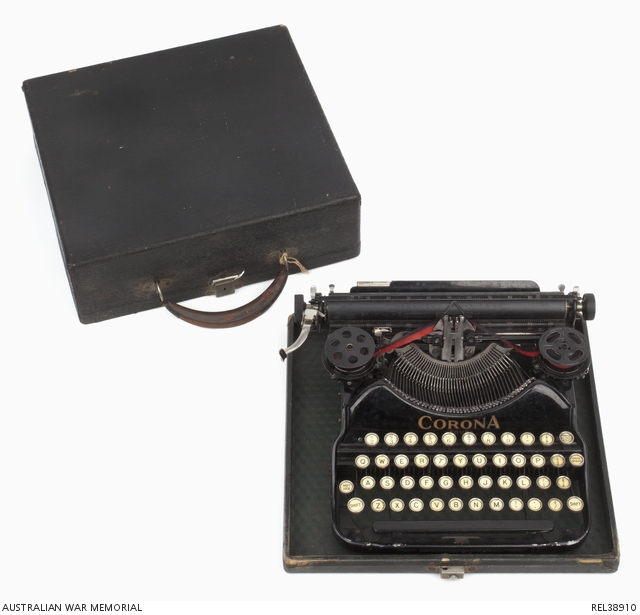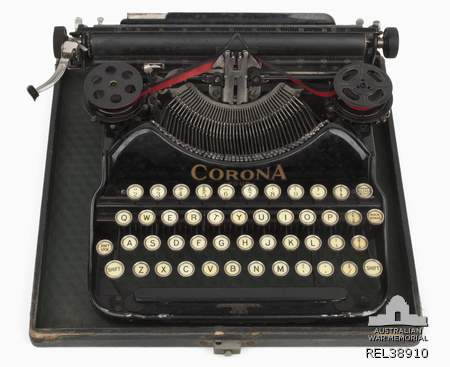| Places | |
|---|---|
| Accession Number | REL38910 |
| Collection type | Heraldry |
| Object type | Personal Equipment |
| Physical description | Bakelite, Cardboard, Celluloid, Cotton, Enamelled metal, Ink, Leatherette, Metal, Rope, Rubber, Vulcanised rubber (Ebonite), Wood |
| Maker |
Smith-Corona Typewriters |
| Place made | United States of America |
| Date made | 1926 |
| Conflict |
Period 1930-1939 Second World War, 1939-1945 Period 1920-1929 British Commonwealth Occupation Force, 1946-1952 (Japan) |
Corona Four Typewriter : Captain M B Tindale, British Commonwealth Occupation Force


Black non-folding, manual, portable, desktop typewriter complete with wooden and leatherette carry case. The aluminium and tin body is finished in black enamel paint. Forty two full size individual keys make up the four banks of the keyboard. Each key is circular with a white cardboard backing featuring a single black letter covered in celluloid. The name 'CORONA -FOUR-' is decoratively printed in gold on the upper front surface. The carriage is mounted on ball and roller bearings. The type bars are made from flat steel with heels to prevent battering, these are mounted in a solid slotted segment.
A black and red ink impregnated cotton roll is still attached to the typewriter. The spools for the roll both appear to be missing circular decorative covers. The typewriter sits upon four rubber stoppers, with the rear two largely flattened and disfigured. A natural metal external lockable latch is on the centre front of the carry case, and a pair of interconnecting hinges are on the rear, facilitating the opening and closing of the box. Inside the carry case are a pair of natural metal clips for securing the rear of the typewriter and a single natural metal fastener at the front. Inside the carry case lid are a pair of metal clamps to prevent the movement of the typewriter while in transit.
This Corona Four typewriter was used by Captain Murray Barnett Tindale during the Second World War and afterwards, during the occupation of Japan. This typewriter was used during the war crimes trials and for intelligence operations, interrogation of suspected and known Japanese war criminals, and interpreting duties for the 2nd Australian War Crimes Section, the Allied Translators and Interrogation Section (ATIS) and British Commonwealth Occupation Forces (BCOF).
The Corona Four model typewriter was a popular model and was produced between May 1924 and 1941 when the factory ceased production to make rifles for the American war effort. The serial number for this typewriter, '2K13979', indicates it was made in March or April 1926.
Murray Barnett Tindale was born on 31 March 1902 in Perth, WA. His family lived in Japan from 1907 to 1915, where his father worked as an accountant at the Salvation Army mission. After they returned to Australia they re-settled in South Australia.
Tindale's service records are unclear about when and where he joined the Second AIF, although his records state that he was living at Bondi, NSW when he enlisted. It appears that Tindale had earlier served in the Citizen Military Forces (CMF) in New South Wales at some stage before 1943, as he had the service number of N461644. Upon joining the Second AIF he was allocated the service number NX190436.
Tindale was discharged on 7 March 1947. His last unit being the Combined Services Detailed Interrogation Centre (CSDIC) in Japan. There were several CSDIC units in operation around the world during the Second World and in the period immediately after. This unit was operated by the British War Office on a joint basis involving the British Army and various intelligence agencies, including MI5 and MI9. CSIDICs were originally established to interrogate detainees, defectors, and prisoners of war who were known or suspected to be working for Nazi Germany or Imperial Japan. After the war, suspected Soviet agents were also held for interrogation.
In 1948 Murray was awarded the prestigious US Presidential Medal of Freedom on the order of President Harry S Truman for his work with US forces in the liberation of the Philippines in 1944 and 1945.